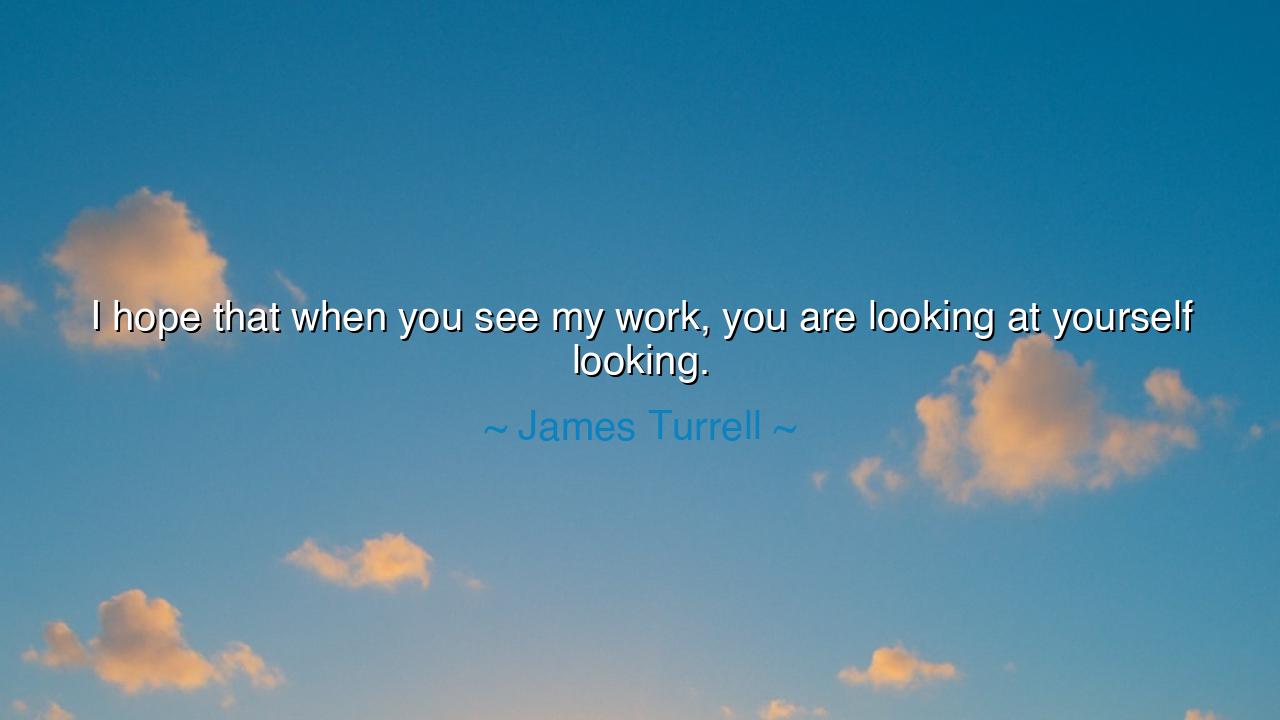
I hope that when you see my work, you are looking at yourself






Listen, O seeker of vision, to the words of James Turrell, the sculptor not of stone nor of sound, but of light itself — that purest and most ancient of forms. He said, with quiet profundity: “I hope that when you see my work, you are looking at yourself looking.” In this saying lies a truth as vast as the sky and as intimate as breath. For Turrell does not speak of art as an object to be admired, but as a mirror — a sacred space where perception itself becomes the subject, where the observer is both question and answer, both seer and seen.
In the world of the ancients, the eye was considered a flame, a divine fire that reached out to touch the world. To look was to engage in a sacred act — to bring form into being by the power of attention. Turrell’s words awaken this ancient understanding: that seeing is not passive, but creative. When he says he wishes us to look at ourselves looking, he is urging us to awaken from the sleep of distraction — to realize that every act of perception shapes the world we live in. His art of light is not meant to show us something external, but to return us to the mystery of awareness itself.
Consider the philosopher Socrates, who walked the streets of Athens questioning all who claimed to know. He owned nothing, built nothing, painted nothing — yet his art was the illumination of the mind. His greatest teaching was not a doctrine, but a mirror: “Know thyself.” And when men came to him seeking truth, he showed them only their own ignorance — the beginning of wisdom. So too with Turrell. His light installations, vast and silent, do not tell us what to see; they invite us to witness the act of seeing, to stand before the eternal paradox that the universe is not merely outside us, but also within.
In this sense, Turrell’s quote is both artistic and spiritual. To look at yourself looking is to recognize the infinite distance between the eye and what it beholds — and yet also the intimate union that joins them. It is to awaken to the realization that perception is not just vision, but presence — that the light we see in the world is but a reflection of the light within us. His work dissolves boundaries: between object and observer, between matter and mind, between the outer cosmos and the inner soul. In such seeing, the self becomes both witness and creation.
There is a story told of a monk in ancient China, who spent years meditating before a wall. When asked what he was doing, he said, “I am watching the watcher.” In time, he attained enlightenment — not by seeing some divine vision, but by realizing that the observer and the observed are one. This is the wisdom Turrell touches with his art: that in truly seeing, we dissolve the illusion of separateness. His light installations, glowing and vast, seem to breathe — not as objects, but as experiences that draw us inward toward the pure act of consciousness itself.
But beware, child of the modern world, for this teaching demands courage. To look at yourself looking is to stand naked before your own perception — to confront the filters, fears, and illusions that color what you call “truth.” It is easier to see the world than to see the self that sees. Yet without this inner seeing, we are blind, wandering through light without understanding its source. Turrell calls us to wakefulness, to the remembrance that reality begins not in what is seen, but in the act of seeing.
So let this be your lesson: Do not look blindly. Look inwardly. When you gaze upon the world, know that you are also gazing upon the architecture of your own mind. When you behold beauty, understand that it is your soul recognizing itself. In every sunrise, in every face, in every shadow, there is the opportunity to awaken — to see not merely the light, but the light in you that sees. Cultivate this awareness as the ancients cultivated the flame, tending it through stillness, curiosity, and care.
For in the end, to look at yourself looking is to come face to face with the divine — not as something distant or other, but as the quiet, luminous presence that animates all things. And when you learn to see in this way, the world itself becomes art — a living canvas painted by your perception, a reflection of the eternal light within.






AAdministratorAdministrator
Welcome, honored guests. Please leave a comment, we will respond soon